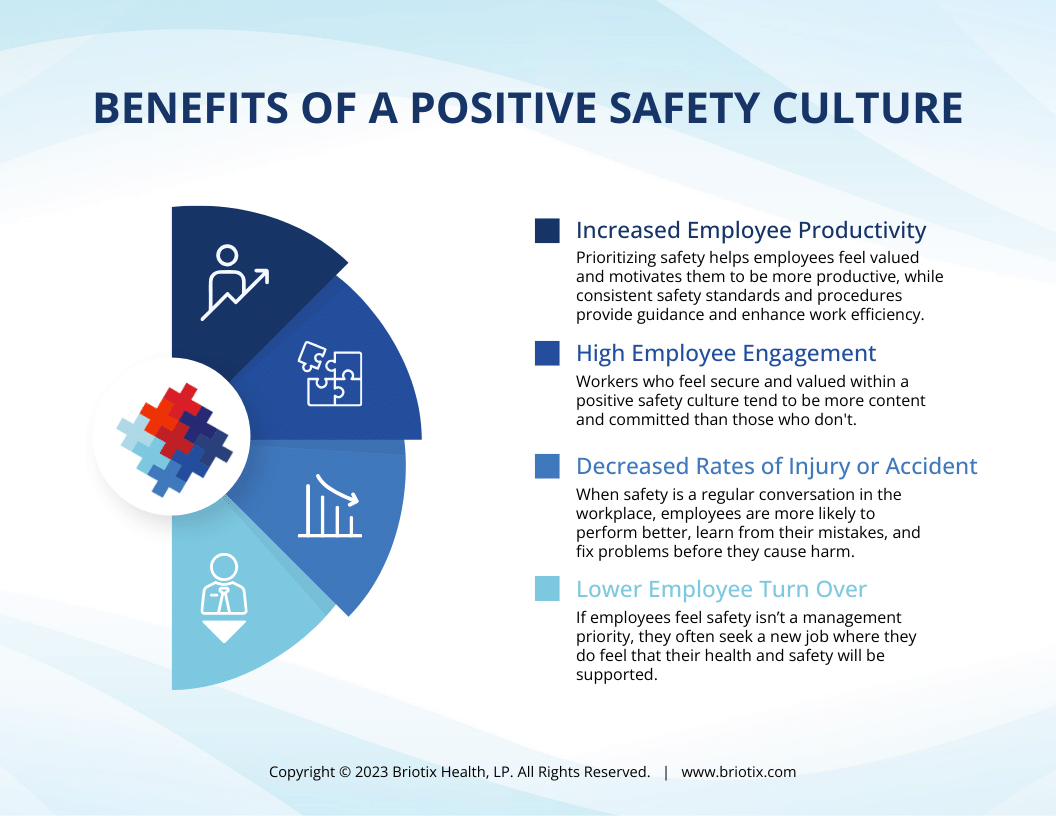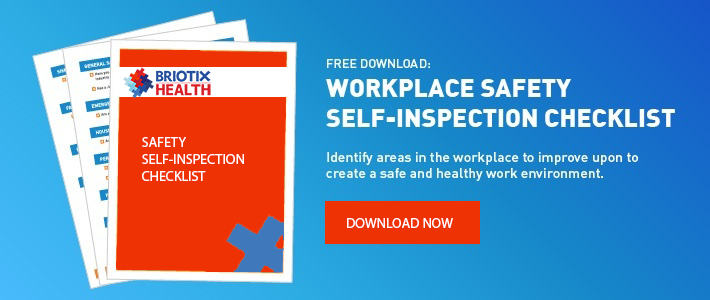
According to the Bureau of Labor Statistics, in 2016 alone 5,190 people died while doing their jobs. That’s more than 14 people per day. Many of these deaths were completely preventable.
Creating a positive safety culture within an organization has shown to dramatically reduce the rate of injuries and accidents in the workplace. However, to effectively develop a culture of safety, we must look beyond accident/injury prevention and start examining the way we work.
What Is a Safety Culture?
Understanding the workplace culture within an organization is rather easy; all one must do is look at the way things are done. The concept of a safety culture therefore looks beyond specific safety policies and programs but captures the mindsets and behaviors towards safety of all company stakeholders–employees, managers, and owners.
A positive safety culture in the work environment is critical to the success and effectiveness of any health and safety program.
Positive Safety Culture Characteristics
It is often easier to identify a company that has a negative safety culture than one that has a positive one. Why? A lack of a safety culture often means safety initiatives are not bought into by employees and often fail leading to higher rates of injury and accidents within the work environment.
While creating a positive safety culture may seem daunting, once the investment is made in building a culture of safety, the benefits are evident in all aspects of the company. Organizations with a strong safety culture often experience:
- Increased employee productivity
- High employee engagement
- Lower turn over
- Decreased rates of injury or accident
What does a positive culture of safety look like? While qualities may differ from organization to organization, companies with a strong safety culture share several characteristics, including:
- Company leaders value employee safety
- Managers are committed to changing the work environment for the better
- Employees feel empowered to take action
- Employees feel ownership over the safety of themselves and team members
- Investments are made in safety procedures, programs, and equipment

How to Build a Safety Culture in 9 Simple Steps
Creating a safety of culture in an organization is the responsibility of all company stakeholders and should be viewed as an ongoing process. Companies with a true safety culture never stop trying to improve upon past goals. The commitment results in a positive attitude towards safety which leads to a reduction in injuries and accidents. Here are ten steps to get you started in building a strong and effective safety culture:
1. Define Responsibilities
To have an effective safety culture, you must first define responsibilities within your organization. This should be done at all levels of the organization and include policies and goals.
2. Create an Organizational Vision for Safety
It is important that everyone in the company be on the same page when it comes to the organizational vision for safety. It is impossible to reach your safety goal if all company stakeholders are not working towards the same target.
3. Develop a System for Open Communication
Companies with a strong safety culture invest in creating lines of open communication throughout their organization. Keeping employees updated on new safety initiatives is vital to successfully implementing policies and procedures. Monthly safety talks are a great way to share new information and allow for employees to opening communicate around safety within the workplace.
4. Involve All Level of Employees
Creating a safety culture starts from the ground up. It is important that employees of all levels be included in the planning and implementation phase of any new safety initiative. Asking for feedback during the initial planning phases increases buy-in and prevents potential pitfalls further down the line during implementation.
5. Rebuild Reporting System
Your reporting system should be focused on the positive and employees should feel free to share safety concerns without repercussions. Rewarding employees who share safety issues is a great way to start rebuilding your system and encourage others to report.
6. Implement Hands-On Training
Proper training is critical when creating a safety culture within an organization. Sharing best practices and creating opportunities for employees to have hands-on learning sessions help employees retain and successfully implement new safety initiatives. Additionally, investing in quality training shows employees that you care about their safety increasing team member buy in and support.
7. Management Modeling
For any safety initiative to be a success, the procedure must be model from the top down. Managers must make a commitment to embody a safety-first work style and continuously demonstrate that safety is important and valued.
8. Hold Employees Accountable
Organizations that truly embody a safety culture have an overwhelming feeling that safety is important. Every team member feels responsible for their individual and co-worker’s safety. A big part of this ownership is holding employees accountable. The more an employee understands and feels accountable for safety initiatives, the more likely they are to take action to improve safety within the company.
9. Celebrate Success
Keeping team members motivated and updated about company progress is important to drive safety initiatives. Recognizing individuals, departments, and the organization as a whole for improvements is an effective way to keep team members excited and invested in building a culture of safety.
10. Commit to Continual Growth
A company that truly embodies a culture of safety understands that while success must be celebrated, there is always room for some improvement. Committing to constant growth and putting in place systems for continuous improvement ensures your organization will not remain stagnant in their results but continue to strive for an injury- and accident-free work environment.
Instilling a positive safety culture within the workplace not only improves employee health but also impacts the way many employees feel about their company increasing the positive feelings about your organization.
If you have questions about building or sustaining a culture of safety, or how Briotix Health can be involved in improving the health of your employees, contact us. Our Injury Prevention Specialists are committed to making it better for you and your workers.
